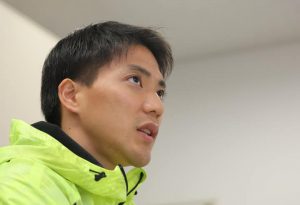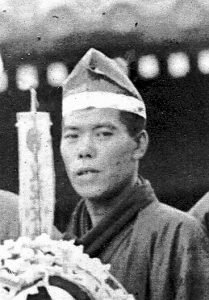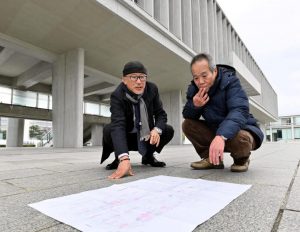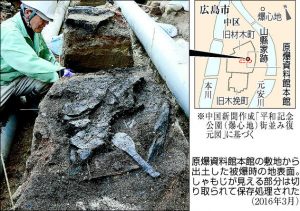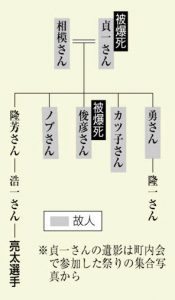Beginning of Hiroshima Summit year makes family in A-bombed city think about “that day”: Great-grandfather of sprinter athlete Ryota Yamagata died in atomic bombing
Jan. 1, 2023
by Michiko Tanaka, Senior Staff Writer
Hiroshima, the A-bombed city, is to be the venue of the summit meeting of G7 (The Group of Seven industrialized nations) from May 19 through 21. The area of Peace Memorial Park, where the leaders are expected to visit, used to be one of the most bustling shopping streets in the city. Many people lived a life there. Then, on that day, a single atomic bomb erased the city and took countless of lives. One of them was the great-grandfather of Ryota Yamagata, 30, Seiko’s athlete holding the 100-meter national record in Japan. The Chugoku Shimbun followed the course of Mr. Yamagata’s family and listened to his family members about their feelings.
Mr. Yamagata has repeatedly used the phrase: “towards the better world.” Once you come to know his family history, his words increasingly carry more weight. His great-grandfather was Sadaichi Yamagata who lived in Hiroshima’s Zaimoku-cho (now part of the city’s Naka Ward). The Yamagata family lived in the place where the Hiroshima Peace Memorial stands now, until the atomic bomb exploded.
According to the public documents and stories from the surviving family, Sadaichi was originally born in the island of Miyajima. As he was clever with his hands, Sadaichi earned a living as a woodcrafter. He then got married to Sagami (who died at age of 82 in 1983). After their first son Isamu (who died at age of 91 in 2015) was born, the family moved to Kobiki-cho in the south of Zaimoku-cho. Sadaichi and Sagami then had four more children there and got their new business on its feet. Under the name of “Yamagata hamono sho (Yamagata cutting tool company),” they produced and sold the carpenter tools.
However, the family was embroiled in the Pacific War, too. Their son Isamu, who had been helping the family business, was drafted into military service and became a crew member on the battleship Ise. As Sadaichi’s home was forced to relocate, his family moved to Zaimoku-cho. Then they started constructing a shack in present-day Itsukaichi-cho in Saeki Ward, as they thought it was better to evacuate to the suburbs. Under these circumstances, the day of August 6, 1945 came.
Nobu Yoshimoto, the family’s second daughter (who died at age of 69 in 2001), once shared what had happened to the family on that day, in response to an interview from the Chugoku Shimbun when she was still alive. Ms. Yoshimoto, then a schoolgirl, experienced the atomic bombing at the Hiroshima Chokin Bank located in present-day Senda-machi in Naka Ward, about 1.6 kilometers away from the hypocenter, where she was mobilized to work. Her father Sadaichi, who had just returned from Itsukaichi the night of August 5, was killed at home by the bombing. He was 51. The family cremated his body on August 8. Ms. Yoshimoto said, “My knees were shaken after I saw my father’s body with only its head coming out from the ground. When my mother put his cremated Adam’s apple bone into the urn, I couldn’t help but turn my eyes away from it.”
Toshihiko Yamagata, the family’s second son who was then 16, died in the bombing, too. Toshishiko was a fourth-year student at Hiroshima Municipal First Technical School (now Hiroshima Prefectural Technical High School). He was typically mobilized to work at the military factory in the suburbs, but on that particular day, was ordered to work to dismantle buildings north of the prefectural government office, which was then located in Kako-machi (now part of Naka Ward), south of his home. As his body, nor his remains could be found, his photograph, the only picture available at the family, was put into the grave instead.
Five out of seven members in the family survived the war. In late July 1945, the battleship Ise which Isamu Yamagata, the family’s eldest son, was aboard, came under attack in the offshore area of Kure, Hiroshima Prefecture, and ran aground. He narrowly escaped death and entered Hiroshima seven days after the atomic bombing. For eight hours, the maximum time permitted for him by the military, he desperately searched for his family but had to leave the city without finding any clues. He later wrote about that experience.
After the war, Isamu lived in Nakajima-cho, the area across from Peace Memorial Park, and sustained the family by engaging in machinery manufacturing. According to Ryuichi Yamagata, 69, Isamu’s eldest son living in Kure, Isamu didn’t talk much about the horrific conditions in the aftermath of the atomic bombing but shared his memory about the beauty of the river where he had played in his childhood, and the vibrant atmosphere of neighboring shops. He had frequently drawn pictures of the area around Peace Memorial Park.
Out of Sadaichi’s five children, Takayoshi Yamagata, 88, the youngest living in Nishi Ward, is still alive. He is Ryota Yamagata’s grandfather. Back then, Takayoshi had been looked after by relatives in Miyajima, but returned home one day before the bomb was dropped, and experienced the bombing in Senda-machi. It is said he had fled with Katsuko Ichinose, his elder sister who passed away in her mid-20s after the war.
However, Takayoshi has never shared his memory about that time at all. Koichi Yamagata, 62, Takayoshi’s eldest son and Ryota’s father, remembers the day when Barack Obama, then the president of the United States, visited Hiroshima in May 2016. He was moved by Mr. Obama’s speech, but found his father had angry eyes, which were usually calm. Koichi said, “The atomic bombing ripped away his father, elder brother and life as it was from him. As he has overwhelming emotions that he cannot described simply with the word ‘unreasonable,’ I assume he doesn’t dare to say anything at all.”
The actual situation of the family’s atomic bombing experience was revealed to the public in an unexpected way. When the Hiroshima City Culture Foundation excavated the area of the Peace Memorial Museum’s main building from 2015 through 2017 prior to its anti-seismic renovation, a partial surface of the ground discovered was cut out by the foundation for preservation. It was later found the surface was highly likely to be the remains of the Yamagata family’s home.
Evidence of the family’s life devastated by the atomic bombing was hidden at 75-centimeters below ground, and included charred rice scoop, a 1.8-liter glass bottle with cooking oil still remaining inside, and remains of casting nets and weights. Koichi shared what his feelings at the time, saying “They were buried just a couple of inches under our feet. It was shocking to me because it made me think that the soil of the area had been completely prepared, and we just went on living as if nothing had happened.”
In May, G7 leaders may set their feet on the soil of the place associated with the Yamagata family. Ryuichi said, “I hope those who will visit that site shouldn’t forget the fact that it is a kind of gravesite as well.” Koichi emphatically said, “It is a place where we can show visitors the reality of what would happen if a nuclear weapon is used against humans again. I definitely would like the leaders, who are authorized to press the nuclear button, to understand the regret they would feel once the weapon is used.”
Bring the world to a better direction
“Since I was a child, I was often conscious of peace. I hope my performance will help make society better, and have many people think sports are important,” said Ryota Yamagata.
He was born in Hiroshima’s Nishi Ward, and began athletics at Suzugamine Elementary School in his local district, and continued after he entered Shudo Junior & Senior High School, and Keio University. In June 2021, he set a Japanese record of 9.95 seconds for the men’s 100 meter. To break his own record, he continues to practice while based in Yokohama, Kanagawa Prefecture, trying to better himself.
While performing well as the representative sprinter in Japan, he keeps thinking of questions such as how he could show his gratitude to his hometown, and what the purpose of running is for him in the first place. Part of his answer to those questions were indicated when he said, “I join this event to make the world better place through sports” when he made a pledge in the opening ceremony of the 2020 Tokyo Olympics in summer 2021 for which he served as the captain of the Japanese team.
He has joined the Olympics, also known as the “festival of peace”, three times. He also shows high expectations for the Hiroshima Summit, which will be held as an historic international conference in his hometown, for conveying a message of peace. “The only thing I want to say about the summit is it would be great if constructive discussions take place to bring the world toward a better direction.”
(Originally published on January 1, 2023)
Hiroshima, the A-bombed city, is to be the venue of the summit meeting of G7 (The Group of Seven industrialized nations) from May 19 through 21. The area of Peace Memorial Park, where the leaders are expected to visit, used to be one of the most bustling shopping streets in the city. Many people lived a life there. Then, on that day, a single atomic bomb erased the city and took countless of lives. One of them was the great-grandfather of Ryota Yamagata, 30, Seiko’s athlete holding the 100-meter national record in Japan. The Chugoku Shimbun followed the course of Mr. Yamagata’s family and listened to his family members about their feelings.
Their life extinguished, resting now beneath the ground of the Peace Memorial Museum and awaiting visit from the G7 leaders
Mr. Yamagata has repeatedly used the phrase: “towards the better world.” Once you come to know his family history, his words increasingly carry more weight. His great-grandfather was Sadaichi Yamagata who lived in Hiroshima’s Zaimoku-cho (now part of the city’s Naka Ward). The Yamagata family lived in the place where the Hiroshima Peace Memorial stands now, until the atomic bomb exploded.
According to the public documents and stories from the surviving family, Sadaichi was originally born in the island of Miyajima. As he was clever with his hands, Sadaichi earned a living as a woodcrafter. He then got married to Sagami (who died at age of 82 in 1983). After their first son Isamu (who died at age of 91 in 2015) was born, the family moved to Kobiki-cho in the south of Zaimoku-cho. Sadaichi and Sagami then had four more children there and got their new business on its feet. Under the name of “Yamagata hamono sho (Yamagata cutting tool company),” they produced and sold the carpenter tools.
However, the family was embroiled in the Pacific War, too. Their son Isamu, who had been helping the family business, was drafted into military service and became a crew member on the battleship Ise. As Sadaichi’s home was forced to relocate, his family moved to Zaimoku-cho. Then they started constructing a shack in present-day Itsukaichi-cho in Saeki Ward, as they thought it was better to evacuate to the suburbs. Under these circumstances, the day of August 6, 1945 came.
Nobu Yoshimoto, the family’s second daughter (who died at age of 69 in 2001), once shared what had happened to the family on that day, in response to an interview from the Chugoku Shimbun when she was still alive. Ms. Yoshimoto, then a schoolgirl, experienced the atomic bombing at the Hiroshima Chokin Bank located in present-day Senda-machi in Naka Ward, about 1.6 kilometers away from the hypocenter, where she was mobilized to work. Her father Sadaichi, who had just returned from Itsukaichi the night of August 5, was killed at home by the bombing. He was 51. The family cremated his body on August 8. Ms. Yoshimoto said, “My knees were shaken after I saw my father’s body with only its head coming out from the ground. When my mother put his cremated Adam’s apple bone into the urn, I couldn’t help but turn my eyes away from it.”
Toshihiko Yamagata, the family’s second son who was then 16, died in the bombing, too. Toshishiko was a fourth-year student at Hiroshima Municipal First Technical School (now Hiroshima Prefectural Technical High School). He was typically mobilized to work at the military factory in the suburbs, but on that particular day, was ordered to work to dismantle buildings north of the prefectural government office, which was then located in Kako-machi (now part of Naka Ward), south of his home. As his body, nor his remains could be found, his photograph, the only picture available at the family, was put into the grave instead.
Five out of seven members in the family survived the war. In late July 1945, the battleship Ise which Isamu Yamagata, the family’s eldest son, was aboard, came under attack in the offshore area of Kure, Hiroshima Prefecture, and ran aground. He narrowly escaped death and entered Hiroshima seven days after the atomic bombing. For eight hours, the maximum time permitted for him by the military, he desperately searched for his family but had to leave the city without finding any clues. He later wrote about that experience.
After the war, Isamu lived in Nakajima-cho, the area across from Peace Memorial Park, and sustained the family by engaging in machinery manufacturing. According to Ryuichi Yamagata, 69, Isamu’s eldest son living in Kure, Isamu didn’t talk much about the horrific conditions in the aftermath of the atomic bombing but shared his memory about the beauty of the river where he had played in his childhood, and the vibrant atmosphere of neighboring shops. He had frequently drawn pictures of the area around Peace Memorial Park.
Out of Sadaichi’s five children, Takayoshi Yamagata, 88, the youngest living in Nishi Ward, is still alive. He is Ryota Yamagata’s grandfather. Back then, Takayoshi had been looked after by relatives in Miyajima, but returned home one day before the bomb was dropped, and experienced the bombing in Senda-machi. It is said he had fled with Katsuko Ichinose, his elder sister who passed away in her mid-20s after the war.
However, Takayoshi has never shared his memory about that time at all. Koichi Yamagata, 62, Takayoshi’s eldest son and Ryota’s father, remembers the day when Barack Obama, then the president of the United States, visited Hiroshima in May 2016. He was moved by Mr. Obama’s speech, but found his father had angry eyes, which were usually calm. Koichi said, “The atomic bombing ripped away his father, elder brother and life as it was from him. As he has overwhelming emotions that he cannot described simply with the word ‘unreasonable,’ I assume he doesn’t dare to say anything at all.”
The actual situation of the family’s atomic bombing experience was revealed to the public in an unexpected way. When the Hiroshima City Culture Foundation excavated the area of the Peace Memorial Museum’s main building from 2015 through 2017 prior to its anti-seismic renovation, a partial surface of the ground discovered was cut out by the foundation for preservation. It was later found the surface was highly likely to be the remains of the Yamagata family’s home.
Evidence of the family’s life devastated by the atomic bombing was hidden at 75-centimeters below ground, and included charred rice scoop, a 1.8-liter glass bottle with cooking oil still remaining inside, and remains of casting nets and weights. Koichi shared what his feelings at the time, saying “They were buried just a couple of inches under our feet. It was shocking to me because it made me think that the soil of the area had been completely prepared, and we just went on living as if nothing had happened.”
In May, G7 leaders may set their feet on the soil of the place associated with the Yamagata family. Ryuichi said, “I hope those who will visit that site shouldn’t forget the fact that it is a kind of gravesite as well.” Koichi emphatically said, “It is a place where we can show visitors the reality of what would happen if a nuclear weapon is used against humans again. I definitely would like the leaders, who are authorized to press the nuclear button, to understand the regret they would feel once the weapon is used.”
Bring the world to a better direction
“Since I was a child, I was often conscious of peace. I hope my performance will help make society better, and have many people think sports are important,” said Ryota Yamagata.
He was born in Hiroshima’s Nishi Ward, and began athletics at Suzugamine Elementary School in his local district, and continued after he entered Shudo Junior & Senior High School, and Keio University. In June 2021, he set a Japanese record of 9.95 seconds for the men’s 100 meter. To break his own record, he continues to practice while based in Yokohama, Kanagawa Prefecture, trying to better himself.
While performing well as the representative sprinter in Japan, he keeps thinking of questions such as how he could show his gratitude to his hometown, and what the purpose of running is for him in the first place. Part of his answer to those questions were indicated when he said, “I join this event to make the world better place through sports” when he made a pledge in the opening ceremony of the 2020 Tokyo Olympics in summer 2021 for which he served as the captain of the Japanese team.
He has joined the Olympics, also known as the “festival of peace”, three times. He also shows high expectations for the Hiroshima Summit, which will be held as an historic international conference in his hometown, for conveying a message of peace. “The only thing I want to say about the summit is it would be great if constructive discussions take place to bring the world toward a better direction.”
(Originally published on January 1, 2023)

